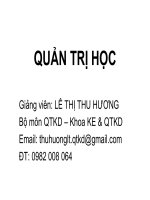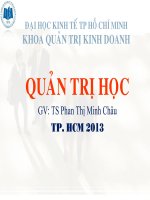Bài giảng môn Quản trị học Chương 5
Bạn đang xem bản rút gọn của tài liệu. Xem và tải ngay bản đầy đủ của tài liệu tại đây (1.07 MB, 33 trang )
5
Chapter
Foundations
of
Planning
© Pearson Education Limited 2015
5-1
Learning Outcomes
• Discuss the nature and purposes of planning.
• Explain what managers do in the strategic
management process.
• Compare and contrast approaches to goal setting
and planning.
• Discuss contemporary issues in planning.
© Pearson Education Limited 2015
5-2
5.1 Discuss the nature
and purposes of
planning.
© Pearson Education Limited 2015
5-3
What is Planning?
Planning:
The primary management function.
© Pearson Education Limited 2015
5-4
Reasons for Planning
© Pearson Education Limited 2015
5-5
Criticisms of Formal Planning
• May create rigidity.
• Can’t replace intuition and creativity.
• Focuses attention on today’s success, not
tomorrow’s survival.
• Reinforces success, which may lead to failure.
© Pearson Education Limited 2015
5-6
Formal Planning and Organizational
Performance
Does it pay to plan?
•
•
•
•
Higher profits
Higher return on assets
Improved quality of planning
Appropriate implementation
© Pearson Education Limited 2015
5-7
5.2 Explain what
managers do in the
strategic
management
process.
© Pearson Education Limited 2015
5-8
Strategic Management
What managers do to develop an organization’s
strategies.
© Pearson Education Limited 2015
5-9
The Importance of Strategic
Management
• It has a positive impact on organizational
performance.
• It prepares managers to cope with changing
situations.
• It guides managers to examine relevant factors in
planning future action.
© Pearson Education Limited 2015
5-10
Steps in the Strategic Management
Process
© Pearson Education Limited 2015
5-11
Step 1: Mission, Goals & Strategies
© Pearson Education Limited 2015
5-12
External and Internal Analyses
Step 2: External
Analysis
•Competition
•Components of
environment
•Threats and
opportunities
Step 3: Internal
Analysis
•Resources
•Capabilities
•Core competencies
•Organizational
strengths and
weaknesses
© Pearson Education Limited 2015
5-13
Formulating, Implementing, and
Evaluating Results
Step 4:
Formulating Strategies
•Corporate
•Business
•Functional
Step 6: Evaluating
Results
•How effective have
strategies been?
•What adjustments are
necessary?
Step 5:
Implementing Strategies
© Pearson Education Limited 2015
5-14
Strategies Managers Use
© Pearson Education Limited 2015
5-15
Stability and Renewal Strategies
Stability strategy:
Organization continues
to do what it’s doing
Renewal strategy:
Organization addresses
declining organizational
performance
• Retrenchment
• Turnaround
© Pearson Education Limited 2015
1-17
Competitive Strategy
A competitive strategy is a strategy for how an
organization will compete in its business.
© Pearson Education Limited 2015
1-18
Competitive Advantage
What sets an organization apart; its distinctive
edge that comes from its core competencies and
resources.
© Pearson Education Limited 2015
1-19
Functional Strategy
Those strategies used by an organization’s various
functional departments to support the
competitive strategy.
© Pearson Education Limited 2015
1-20
Strategic Weapons
1.
2.
3.
4.
5.
6.
Customer service
Employee skills & loyalty
Innovation
Quality
Social media
Big data
© Pearson Education Limited 2015
1-21
Strategic Weapons (cont.)
5. Social Media
•Help people connect
•Reduce costs and/or
increase revenue.
6. Big Data
Translate business
knowledge into
improved decision
making and
performance.
© Pearson Education Limited 2015
1-22
5.3 Compare and
contrast
approaches to goal
setting and
planning.
© Pearson Education Limited 2015
5-23
Setting Goals and Developing Plans
Types of Plans
Financial versus strategic
Stated versus real
© Pearson Education Limited 2015
5-24
Traditional Goal Setting
© Pearson Education Limited 2015
5-25
Management by Objectives
1.
2.
3.
4.
Goal specificity
Participative decision making
Explicit time period
Performance feedback
© Pearson Education Limited 2015
5-26









